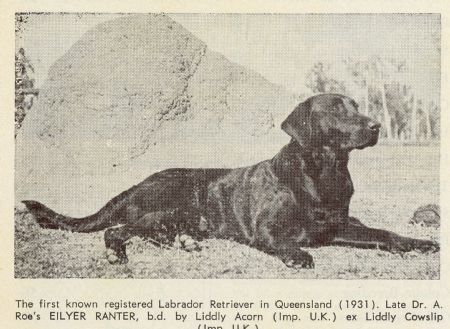Club History

History of the Labrador Retriever in Australia from 1929-1983
Click the above link for an interesting read on the history of the Labrador Retriever in the early days here in Australia.
History of the Labrador Retriever in Queensland
The first Labrador arrived in Queensland in 1931. He was Dr. A. Roe's black dog Eilyer Ranter sired by Liddly Acorn (imp UK) ex Liddly Celandine (imp UK) and is generally believed to be from the first registered Labrador litter whelped in Victoria.
The breed was unknown in Queensland and when his photograph appeared in the newspaper of the day, the caption described "Ranter" as a Labrador Terrier.
Dogs owned by Mr G. Newman, of Caboolture, Mr D. McDonald, of Peachester, and Sir Edwin Tooth formed the nucleus of breeding stock in pre-war Queensland. Whether any of these original lines still exist is not known but a dog and a bitch owned by Mr Newman were successful at the Brisbane Royal in 1939, 1940 and 1941.
The first yellow Labrador was registered in Queensland in 1945 - a bitch Winlaton Glint by Winlaton Sultan ex Liddly Queencake, bred by Miss Lascelles of Victoria and owned by her niece Miss Minapre Steuart, then a student at the University of Queensland.
Mrs Norah Gilbert arrived from England in 1952 with her family and foundation bitch Aust. Ch Clacton Gay Lady, (imp UK) of Liddly, Poppleton and Sandylands breeding. Mated to various sires she established the Jaywick prefix and her progeny acquired five championship titles and six Brisbane Royal Challenges between them.
Mrs Helen Sapio travelled from New Zealand in 1953 with her Labradors. Her Cruchfield prefix is behind many present day Labradors in both Queensland and New South Wales.
By the mid sixties there were many new prefixes making an impact. These included Rozea, Baringa, Grosvenor, Tygala, Chiverton and Wynnstay. The popularity of the Labrador Retriever has grown steadily since those early years with the most rapid increase being realised between 1965 and 1972 as the registrations indicate: 323 in 1965 to 1,621 in 1972.
During the 1970s and 80s many more significant Labrador prefixes were established and most have prospered to the present day among them: Waglett, Charmerla, Avokah, Dewick, Geijera, Tenarda, Maraposa, Lakewood, Eastlair, Delmundi, Guildel, Wintoppi, Shadovale and Southbank.
Formation of the Labrador Retriever Club of Queensland
In 1964, during a championship show at Ipswich Mrs Norah Gilbert suggested to a small gathering of Labrador breeders, owners and exhibitors that the CCCQ would approve the affiliation of a Labrador Club in Queensland and plans were immediately put in place to gather members and to develop the first Club constitution.
From these humble beginnings the club today boasts membership not only in Queensland but throughout Australia and overseas.
The LRCQ was initially a social club during 1964/65 after which time full affiliation was granted.
The first Parade (Open Show) was held at the end of 1965 followed by the first Championship Show in July 1966.
The Labrador Club is dedicated to the betterment of the breed and encourages members to promote the virtues and abilities of their stock. To this end retrieving trials are conducted, the first of which was held in 1967, and a Championship Show and Parade (Open Show) convened annually.
Members strive for excellence in all fields of endeavour – Conformation championship shows, non-slip retrieving trials and obedience trials and those whose dogs succeed enjoy much sought after annual Club trophies.
The LRCQ published yearbooks until 1973 followed by a bi-monthly edition of 'Otter Tales' (which you can still subscribe to today - by joining the LRCQ Inc.) and the very popular and informative Labradors in Capricornia now in its 6th edition.
Two members, Miss Margaret Piddington and Mrs Elaine McDonald, were responsible for publishing Labradors of Australia and New Zealand in 1979, supplemented annually until 1983. Sales extend to England, the US, Canada, Sweden, South Africa and New Zealand.
